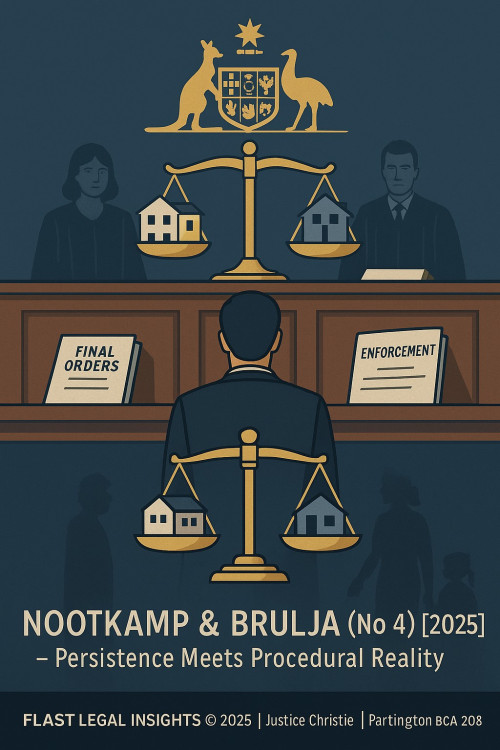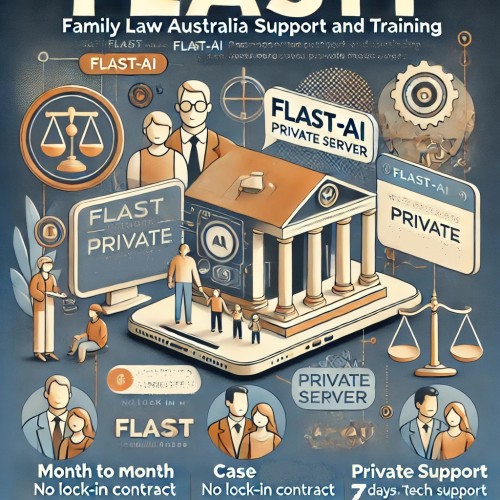In Willis & Mulder [2025] FedCFamC1A 217, Justice Austin of the Federal Circuit and Family Court (Division 1, Appellate Jurisdiction) overturned a property settlement after the wife uncovered explosive new evidence — her husband, who claimed to be a pensioner with no income, had secretly declared a $176,000 annual salary to a lender just months later. The appellate court found that while the trial judge made no legal errors based on the original evidence, the husband’s post-trial loan documents “collided violently” with his sworn testimony. This new evidence fatally undermined the trial findings under s 75(2) of the Family Law Act 1975 (Cth), leading the Court to set aside the orders and send the matter back for rehearing.
📜 Facts and Issues
Facts
- The parties married in 2006 and separated in 2021.
- The wife commenced property proceedings in 2023; the husband, self-represented at trial, claimed he was on a Commonwealth old-age pension with no other income.
- The primary judge divided property 65/35 in the husband’s favour, rejecting claims of non-disclosure and finding both parties equally deficient in financial transparency.
- Shortly after judgment, the wife obtained loan application documents showing the husband declared an annual taxable income of $176,000, and affirmed he was self-employed.
- The wife appealed, arguing this new material proved both non-disclosure and a miscarriage in the primary judge’s s 75(2) assessment.
Issues
- Whether the husband’s undisclosed income and post-trial loan documents justified admitting fresh evidence on appeal.
- Whether the trial judge erred in failing to adjust property division under s 75(2) for financial disparity.
- Whether non-disclosure or false evidence warranted setting aside the final orders.
⚖️ Law
Statutory Framework
- Family Law Act 1975 (Cth) ss 75(2), 79 — financial and contribution-based adjustment principles.
- Federal Circuit and Family Court of Australia Act 2021 (Cth) s 35(b) — power to receive further evidence on appeal.
- Evidence Act 1995 (Cth) s 164 — corroboration not required for acceptance of probative evidence.
Key Precedents
- CDJ v VAJ (1998) 197 CLR 172 – new evidence on appeal admissible if credible, material, and likely to produce a different result.
- Allesch v Maunz (2000) 203 CLR 172 – power to remit matter for rehearing if justice requires.
- Weir & Weir (1993) FLC 92–338 – consequences of deliberate non-disclosure.
- Gould & Gould (2007) FLC 93-333 – degrees of non-disclosure and their forensic consequences.
- Franklin & Ennis [2019] FamCAFC 91 – non-disclosure is not self-punishing; its impact depends on circumstances.
🔍 Application
1️⃣ Admissibility of New Evidence
Justice Austin applied CDJ v VAJ and held the wife’s evidence — comprising a broker’s declaration, a tax agent’s letter, and a loan application — met all criteria for admission:
- It was credible and created after the trial, hence unavailable earlier.
- It directly contradicted the husband’s sworn evidence of being on a pension.
- It was highly probative of the husband’s true financial circumstances and likely to affect the outcome on s 75(2) adjustment.
The Court described the husband’s admissions as “colliding violently” with his trial evidence (at [86]) and found that had the evidence been known earlier, the financial outcome would have differed materially.
2️⃣ Non-Disclosure and Section 75(2)
At trial, the husband’s alleged poverty limited the scope for any post-contribution adjustment. With the new material showing hidden income, the Court held the s 75(2) determination was now “vitiated” — particularly factors relating to income disparity, earning capacity, and future needs (at [88]–[89]).
Justice Austin emphasised that non-disclosure findings are means to an end, not punishment: what matters is whether the true financial position alters justice and equity under s 75(2).
3️⃣ No Primary Error, But New Injustice
Importantly, Justice Austin stressed that the primary judge committed no appealable error on the evidence before her (at [2]). The injustice only emerged due to new evidence unavailable at trial. Accordingly, the appeal succeeded not for legal error, but because the subsequent revelations fundamentally changed the factual matrix.
The husband’s “violent collision” of declarations warranted rehearing before a different judge (at [93]–[94]), preserving procedural fairness for both parties.
💬 Analysis of the Judgment
The appellate reasoning in Willis & Mulder highlights two vital principles:
- Fresh Evidence Jurisprudence — Following CDJ v VAJ, the Court reaffirmed that appellate intervention may be justified even absent trial error, where newly discovered facts make the original decision unsafe.
- Non-Disclosure and Forensic Balance — Echoing Weir & Weir and Gould & Gould, Austin J reiterated that not all non-disclosure is equal; its gravity depends on whether it conceals material wealth or merely delays proceedings.
The husband’s deliberate misrepresentation struck at the integrity of the property pool and the credibility of the evidence underpinning the judgment. Hence, justice required a rehearing, not just a recalculation.
🧠 Take-Home Lesson
“Truth told too late is still a lie — and in family property cases, lies cost judgments.”
Willis & Mulder reaffirms that:
- Full and frank disclosure is a continuing obligation under the Family Law Act.
- Post-trial evidence exposing dishonesty can reopen even a final judgment.
- Appellate courts will only disturb discretionary outcomes where new evidence is decisive, credible, and would likely change the result.
The wife’s diligence in obtaining the husband’s loan documents illustrates how forensic persistence can unearth concealed wealth — and overturn injustice.
In Nootkamp & Brulja (No 4) [2025] FedCFamC1A 210, the Full Court of the Federal Circuit and Family Court of Australia (Division 1) dismissed a husband’s fourth attempt to overturn enforcement orders made to implement final property settlement orders from 2024. The self-represented appellant alleged judicial bias, procedural unfairness, and discretionary error, but the Full Court (Austin, Sutherland & Riethmuller JJ) found that he was simply re-litigating issues already determined and had been given ample opportunity to comply with the original orders. The Court reinforced the narrow grounds for alleging bias and the high threshold for obtaining leave to appeal interlocutory property orders.
📜 Facts and Issues
Facts
- Final property orders were made in October 2024 dividing the parties’ assets, including two properties (“Suburb E” to the wife and “Suburb J” to the husband).
- The husband was to pay the wife $128,469, and if he failed, his property (Suburb J) would be sold to satisfy the debt.
- He failed to comply and instead filed multiple enforcement and appeal applications, including to the High Court, all of which were dismissed.
- In August 2025, the Family Court made enforcement orders giving the wife possession of Suburb J to sell it if the husband did not pay the required sum.
- The husband appealed again, alleging bias, denial of procedural fairness, and factual error in the judge’s assessment of evidence.
Issues
- Was there judicial bias, actual or apprehended, by the primary judge?
- Was procedural fairness denied during the enforcement proceedings (e.g. refusal of adjournment, amendment or cross-examination)?
- Did the trial judge err in exercising discretion in enforcing the final property orders?
- Was there any legal error in applying repealed cost provisions?
⚖️ Law
The Court applied well-established appellate and procedural principles:
- Leave to Appeal (Interlocutory) – Medlow & Medlow (2016) FLC 93-692 at [44]–[57]: leave requires doubt about the correctness of the order and risk of substantial injustice.
- Judicial Bias – Ebner v Official Trustee in Bankruptcy (2000) 205 CLR 337; Vakauta v Kelly (1989) 167 CLR 568: actual bias requires proof the judge was not impartial.
- Procedural Fairness – Parties must have a reasonable opportunity to be heard, but procedural rules must be obeyed (Family Court Rules 2021 (WA) rr 85, 180).
- Costs Transition – Repeal of s 117 of the Family Law Act 1975 (Cth) and introduction of s 114UB under the Family Law Amendment Act 2024 (Cth).
⚖️ Immaterial Legal Error – Use of Repealed Costs Provision
At paragraph [53], the Full Court acknowledged that the primary judge technically erred by referring to section 117 of the Family Law Act 1975 (Cth) — a provision repealed under the Family Law Amendment Act 2024 (Cth) — when determining costs, rather than the current section 114UB.
The error arose because the judgment below was delivered after the commencement of the 2024 amendments, which relocated the costs framework to Part XVIA of the Act. However, the Full Court held that this mistake was immaterial, since the substantive test under both provisions is identical: each requires the Court to consider whether a party should bear costs “having regard to the conduct of the parties and the circumstances of the case.”
There was no difference in the discretion conferred, the considerations applied, or the reasoning used. In short, the citation of the repealed section did not alter the outcome — the judge applied the correct legal principle, albeit under the old section number. Consequently, the appeal could not succeed on this ground, because appellate correction is only warranted where an error is material, meaning it affected the result (House v The King (1936) 55 CLR 499 at 504–505).
🔍 Application
1️⃣ Judicial Bias
The husband’s claims of bias were based on previous adverse comments, alleged preferential treatment of the wife, and repetition of arguments rejected in earlier appeals.
The Court found these entirely without merit, noting that:
- The same allegations had been dismissed in Nootkamp & Brulja (No 3) [2025] FedCFamC1A 116.
- Dissatisfaction with the result does not establish bias (Feldman v Nationwide News (2020) 103 NSWLR 307 at [43]).
- The judge’s comments were contextual and did not show prejudgment.
Result: No actual or apprehended bias was found.
2️⃣ Procedural Fairness
The husband raised five procedural complaints — late amendment, refused adjournment, combined hearing of costs and enforcement, refusal to entertain late amendment, and no cross-examination.
The Court held all five were unsustainable:
- The wife’s amendment was permissible under r 180(1)(b) and caused no prejudice.
- The adjournment refusal was proper — the husband had ample time and resources to obtain advice.
- The combined hearing of costs and enforcement was efficient and fair.
- Late amendment after judgment was reserved was impermissible.
- Cross-examination was barred by s 102NA (self-represented party cannot cross-examine the other party where family violence risk exists).
Result: No procedural unfairness occurred.
3️⃣ Discretion and Evidence
The Court upheld the enforcement orders as a sound exercise of discretion:
- The husband’s application contradicted the final orders and was “ill-conceived”.
- The judge’s factual findings matched the wife’s evidence; the husband failed to specify errors per r 13.23(3).
- Any minor factual dispute was immaterial — he was given time to pay and did so within 28 days.
4️⃣ Immaterial Legal Error
Although the trial judge referenced repealed s 117 instead of new s 114UB, the Full Court ruled this was immaterial because both provisions were substantively identical.
💬 Analysis of Judgment
The Full Court reaffirmed key appellate principles:
- Re-litigation of prior complaints (bias, delay, enforcement) will not succeed.
- The Ebner test requires a reasonable apprehension of bias, not mere dissatisfaction.
- Procedural fairness is about opportunity to be heard, not unlimited procedural indulgence.
- Minor legal missteps are not appealable without material impact (House v The King (1936) 55 CLR 499).
The judges emphasized that self-representation does not exempt a party from procedural compliance or from the consequences of delay and obstruction. The appeal lacked merit, and costs of $15,000 were ordered against the husband.
🧭 Take-Home Lesson
“Persistence is not a substitute for merit — appellate courts will not rescue a party from the consequences of their own non-compliance.”
- Repeated appeals on bias or fairness grounds will fail without clear, demonstrable error.
- The 2024 Family Law reforms modernised costs provisions but didn’t change the substance of fairness tests.
- Courts expect finality — once property orders are made, enforcement is a matter of compliance, not negotiation.
FLAST-AI-Private Server + Basic Membership - Monthly
Includes:
- Basic Membership - Access to FLAST Network, Case Digests, Discussions, Private Member Groups and Online Support.
- Month to Month, No Lock in Contract, 12 Month Subscription, Opt-Out anytime
- FLAST-AI Premium Server (Click on the link to see details of what is included, features etc)
- 5 Days (Monday to Friday) Tech Support.
Pre-requisite : To purchase this product you first need to have the below product for 1 month (which covers set-up costs, initial member training and support)
1 Month - FLAST-AI-Private-Server + Premium Membership + Advanced Mentoring $400
1 Month - FLAST-AI + Premium Membership + Advanced Mentoring
FLAST-AI - Premium Private Server Hosting for 1 Month
Includes:
- 1 Hour Zoom Training Session on how to use the FLAST-AI server and optimize it for your case.
- Online 24/7 Training Course (That teaches you how to prepare, set-up, use, and optimize the FLAST-AI server).
- FLAST Premium Membership
- Unlimited access to the FLAST network, case digests, discussions, private member groups; and
- Online mentoring and guidance - 7 days a week.
- 7 days a week technical support:
- To help with any technical questions you may have.
- Advanced Mentoring Support - Via Zoom/Phone:
- To help you get the most from the FLAST-AI system, to help you master advanced techniques of legal analysis, legal research and document drafting and present your case in the best possible light for you, your lawyers and the court.
- FLAST-AI Fact Checker GPT.

The FLAST-AI Legal Research Assistant has been custom trained on Australian Family Law.
Case Analysis
You can use it to ask it Legal Questions as a Legal Research Assistant and it will provide you answers using the IRAC Analysis Method of the Facts, the Legal Issues, the Relevant Law, relevant sections of Legislation, Regulations and Rules that apply, an Analysis with supporting verified caselaw to support the position it is arguing and a conclusion with a proposed outcome.
Document Drafting
FLAST-AI can help with :
- Creating Chronologies
- Case Outlines (both Interim and Final Trial)
- Affidavit Outlines and help with detailed Final Trial Affidavits.
- Responding to legal correspondence from the other parties
- Submissions
- Creating Briefs for Barristers
Evidence Analysis
- Analyze Affidavits for errors or conflicting information
- Analyze Expert Reports for bias or other irregularities
Think about the amount of time this will save you.
Create Multiple Databases with your case file data
You can upload all your case file data, from Applications, Notices of Risk, Affidavits, Case Outlines, Expert Reports, Correspondence between the parties, Judgements and the system supports .pdf, .txt or .html format documents or video/audio recordings in .mp3, .mp4 and mpeg formats for analysis and extraction of text, transcribing video and/or audio recordings into precise text and creating a summary of the recording for you to review.
Save Money on Legal Fees
FLAST-AI can help you present your case in the best light and allow you to provide it to your Lawyer on a silver platter, with all supporting legislation, regulations, rules and case law in your analysis.
If you are interested in the above contact us to arrange a demonstration.
Think about the thousands in legal fees you could save if you could provide all the above on a silver platter for your lawyers to digest in a legal format they can understand that this is well researched.
It doesn't end there, if a decision does not go as you expect, you can continue to quiz and probe your AI Legal Research assistant to look for grounds of appeal.
The output from the FLAST-AI Server when analyzing the data from your case will inform you on the potential grounds of appeal and can include any of the following matters:
- errors of law;
- errors of fact;
- errors of procedure;
- errors of judgment;
- errors in the exercise of discretion; or
- any other matter that is the subject of dispute.
- In relation to the Rule of Court, the grounds of appeal include any of the following matters:
- errors where the primary judge failed to take into account relevant considerations;
- errors where the primary judge took into account irrelevant considerations;
- errors where the primary judge made an error in the exercise of discretion;
- errors where the primary judge failed to exercise discretion when required;
- errors where the primary judge failed to give reasons;
- errors where the primary judge failed to comply with the rules of evidence;
- errors where the primary judge failed to identify an issue or make a finding on an issue;
- errors where the primary judge failed to address a legal argument;
- errors where the primary judge made an error in the interpretation of a statute or other legislation; and
- errors where the judge failed to consider agreement between the parties.
This will then allow a report to be produced with the above information in detail. You will also have your own access to the FLAST-AI server which you will be able to quiz on any issue related to your case.
Safe and Secure
This is hosted on a private server on your own subdomain that you control, only you have access to the data that you populate the AI Legal Researcher with.
The system has inbuilt security with Secure Socket Layer (SSL). SSL is like a digital passport that confirms a website’s identity and protects the information users share with it. When a user sends information to a website, SSL ensures it can’t be read by anyone else by encrypting it. This is especially important for sensitive information like family law personal details.
Think of it as sending a letter in a locked box, and only the recipient has the key to open it. This keeps your information safe and secure.
You can know and see it active in your browser with the padlock icon or the ‘https’ in your address, you’ll know your information is secure.
Got Questions ?
If you have any questions feel free to ask or better still book a free no obligation demonstration, seeing is believing so what not take a look for yourself?
Check out this Video of the FLAST-AI system in Action.
Payment Options :One Month Only (as a trial) - $400.00- Includes 1hr Training Session
- Premium Membership; and
- Advanced mentoring
At the end of the first Month, you can then decide on the following options moving forward :
With Premium Membership and Support ( Month to Month, No Lock in Contract, 12 Month Subscription, Opt-Out anytime)
- FLAST-AI Premium Server on Monthly Contract with Premium Membership and Advanced Mentoring $250 per month.
- Why would you pay an extra $145 per month for this over the Basic Membership?
- The short answer is for the 7 days a week Support and Mentoring.
- For about $4.83 a day (less than a cup of coffee) it means you can have someone who is experienced in Family Law matters assist you personally and directly either by online chat, phone call, zoom meeting or email and provide you help and guidance.
- FLAST-AI Premium Server on Monthly Contract with Basic Membership, 5 Days (Monday to Friday) Tech Support $105 per month.
Most Cost Effective
- FLAST-AI Premium Server for 12 Months $995 with Basic Membership, 5 Days (Monday to Friday) Tech Support.
Adamo vs. Vinci: Upholding Justice through Procedural Integrity and Evidentiary Standards"
Citation:
Adamo & Vinci (No 2) [2024] FedCFamC1A 96
Introduction:
The Federal Circuit and Family Court of Australia, Division 1, delivered a pivotal judgment in the case of Adamo & Vinci (No 2) [2024] FedCFamC1A 96. This appeal case centered around the appellant's attempts to discharge final parenting and property orders, alleging a material change of circumstances and procedural errors by the primary judge.
Facts:
- The appellant (Mr. Adamo) and the respondent (Ms. Vinci) were previously married and have two children.
- Final parenting and property orders were made in October 2020, with the children primarily residing with the respondent.
- The appellant sought to discharge these orders, claiming a material change in circumstances and procedural issues.
- The primary judge dismissed the appellant's application, leading to this appeal.
Issues:
- Whether there was a material change of circumstances justifying the re-litigation of parenting orders.
- Whether the primary judge erred in dismissing the application to set aside property orders under sections 79A(1)(a), (c), and (d) of the Family Law Act 1975 (Cth).
- Whether further evidence should be admitted on appeal.
- Whether the appellant should bear the costs of the appeal.
Rule:
- Family Law Act 1975 (Cth): Sections 79A(1)(a), (c), and (d) for setting aside property orders.
- Evidence Act 1995 (Cth): Section 50 regarding the admissibility of evidence.
- Federal Circuit and Family Court of Australia Act 2021 (Cth): Section 35 for procedural compliance.
Analysis:
Key Paragraphs from the Judgment:
- Material Change of Circumstances: The primary judge found that the appellant had not established a material change in circumstances warranting re-litigation of parenting orders (paragraphs 1-5).
- Paragraph 98: "The primary judge concluded that even based on the appellant's evidence, the children had spent significantly less time with him than provided for in the orders. This was not deemed a change in circumstances."
- Application of Wrong Principles of Law: The appellant failed to elucidate how the primary judge applied wrong principles of law (paragraph 17).
- Paragraph 37: "The appellant's submissions lacked precision, failing to demonstrate the application of wrong principles by the primary judge."
- Admissibility of Further Evidence: The appellant's application to adduce further evidence was dismissed as it lacked materiality and nexus that would alter the primary judge's decision (paragraphs 18-33).
- Paragraph 22: "The appellant could not demonstrate how the omitted documents would have produced a different result at trial."
- Costs: The appellant was ordered to pay the respondent's costs fixed at $18,800 due to the wholly unsuccessful appeal (paragraphs 112-117).
- Paragraph 117: "Impecuniosity is no bar to an award of costs being made."
Reasons for Judgment:
The Court dismissed the appeal, emphasizing that the appellant failed to demonstrate any material change of circumstances or errors in the primary judge's application of legal principles. The application to adduce further evidence was also dismissed due to its lack of relevance and potential impact on the original decision. Costs were awarded to the respondent due to the appellant's wholly unsuccessful appeal.
Take Home Lesson:
This case underscores the importance of establishing a clear and substantial change in circumstances when seeking to alter final parenting and property orders. It also highlights the necessity for precise and relevant evidence in appeals and the potential financial repercussions of unsuccessful litigation.
Justice Denied: Late Appeal Application Dismissed in Pekkanen v Pekkanen
Citation:
Pekkanen & Pekkanen [2024] FedCFamC1A 97
Introduction:
In the Federal Circuit and Family Court of Australia, the case of Pekkanen & Pekkanen [2024] FedCFamC1A 97 involved an application for review of a decision made by the appeal registrar. The applicant sought leave to file an appeal out of time. Justice Austin presided over the matter, ultimately dismissing the application due to the lack of a reasonable explanation for the delay and the unlikelihood of success in the proposed appeal.
Facts:
- Parties Involved: Mr. Pekkanen (Applicant), Ms. Pekkanen (Respondent)
- Nature of the Case: Application for leave to file an appeal out of time
- Initial Judgment: Pekkanen & Pekkanen [2024] FedCFamC2F 46
- Date of Judgment: 18 June 2024
- Decision: Application dismissed
Issues:
- Did the applicant provide an adequate explanation for the delay in filing the appeal?
- Did the proposed appeal demonstrate any reasonable prospect of success?
Rule:
- Family Law Act 1975 (Cth) Pt VII
- Federal Circuit and Family Court of Australia (Family Law) Rules 2021 (Cth) Pt 5.3, r 13.38
Cases Cited:
- CDJ v VAJ (1998) 197 CLR 172; [1998] HCA 67
- De Winter and De Winter (1979) FLC 90-605
- Gallo v Dawson (1990) 93 ALR 479; [1990] HCA 30
Analysis:
Key Paragraphs:
- Paragraph 1: The applicant sought review of the appeal registrar’s decision to reject his Application in an Appeal seeking leave to file an appeal out of time. The application was dismissed on the basis that there was no adequate explanation for the delay, and the proposed appeal showed no reasonable prospect of success.
- Paragraph 12: The applicant's reliance on a document from Country B to support his case was deemed inadmissible, following the principles established in CDJ v VAJ. The absence of this document meant that Grounds 1 and 2 of the appeal would inevitably fail.
- Paragraph 13: The applicant cited difficulties in acquiring the document from Country B due to political instability. However, the document was procured shortly after the judgment, raising questions about why it was not obtained earlier.
- Paragraph 14: The primary judge noted the applicant's failure to disclose a compensation payment of $42,500 received in 2022, which was added back as a notional asset. Any trivial error in the total value of this payment was considered immaterial.
Reasons for Judgment:
Justice Austin dismissed the application primarily because the applicant did not provide a satisfactory explanation for the delay in filing the appeal. Additionally, the proposed appeal lacked any reasonable prospect of success, particularly due to the inadmissibility of the crucial document from Country B.
Take Home Lesson:
Timeliness is crucial in legal proceedings. Failure to provide adequate justification for delays can result in dismissal, and appeals must have a reasonable prospect of success supported by admissible evidence.
Justice Under Scrutiny: Appellant Challenges Primary Judge's Integrity and Seeks Full Court Appeal
Citation
Lim & Zong (No 2) [2024] FedCFamC1A 98
Introduction
The case of Lim & Zong (No 2) revolves around an appellant seeking an appeal to be heard by a Full Court instead of a single judge. The appellant alleges significant errors and deliberate misstatements by the primary judge. The case examines the procedural aspects and the grounds required for such an appeal to be heard by a Full Court.
Facts
- Date of Primary Judgment: 16 April 2024
- Notice of Appeal Filed: 7 May 2024
- Primary Judge: Alleged to have made deliberate misstatements.
- Appellant: Haoyu Liu
- Respondent: Yuanyuan Zhu
- Nature of Complaint: The appellant claims that the primary judge made intentional errors in the judgment and altered submissions to fit her narrative. The appellant seeks that the appeal be heard by a Full Court to address these alleged mistakes.
Issues
- Whether the appellant can justify the appeal being heard by a Full Court instead of a single judge.
- Whether the transcript of the primary judge's oral reasons should be provided, highlighting any corrections.
Rule
The appellant must demonstrate compelling reasons for a Full Court appeal under the Federal Circuit and Family Court of Australia (Family Law) Rules 2021, particularly citing rules 10.13 and 10.14(b) regarding the correction of judgments and orders for transcripts.
Analysis
Key Paragraphs from the Judgment:
- Paragraph 1: Notice of Appeal filed on 7 May 2024, challenging the judgment delivered on 16 April 2024.
- Paragraph 44: The primary judge read out the judgment on 16 April 2024. The reasons for judgment were delivered orally and later corrected for written comprehension.
- Paragraph 16: The court orders the procurement of the transcript of the oral reasons, subject to the appellant reimbursing the court for the cost.
The appellant argues that the primary judge's errors were not just mistakes but deliberate alterations to the facts and submissions. The request for the Full Court to hear the appeal stems from the appellant's lack of confidence in a single judge's ability to impartially review the alleged errors.
The court examines whether the appellant has provided sufficient justification for a Full Court appeal. It considers the procedural correctness and the merits of the appellant's claims, weighing the necessity and practicality of a Full Court hearing versus a single judge review.
Reasons for Judgment
The court ultimately decides to dismiss the application for a Full Court appeal. The primary reason is the lack of sufficient justification from the appellant to deviate from the standard single judge appeal process. However, the court grants the appellant's request for the transcript of the primary judge's oral reasons to be provided, conditional upon the reimbursement of the costs involved.
Take Home Lesson
To challenge a primary judgment successfully and escalate an appeal to a Full Court, appellants must provide compelling evidence and justifications. Mere allegations of error or bias are insufficient without substantial backing. Procedural correctness and adherence to rules are critical in the appellate process.
Family Court Overturns Property Settlement: Husband’s Financial Misconduct Unveiled
Case Citation: Curtain & Curtain (No 4) [2024] FedCFamC1F 348
Introduction:
In a notable decision, the Federal Circuit and Family Court of Australia overturned a property settlement previously agreed upon in 2016, citing significant non-disclosure of financial information by the husband. Justice Mead’s judgment emphasized the imperative of full and frank disclosure in family law proceedings, setting a precedent for future cases involving financial misconduct.
Facts:
In 2016, a property settlement order was made between Mr. and Mrs. Curtain, following their separation. Mrs. Curtain later discovered that Mr. Curtain had failed to disclose substantial financial assets during the original proceedings. She filed an application under section 79A of the Family Law Act 1975, seeking to set aside the 2016 orders on the grounds of non-disclosure and misrepresentation.
Issues:
1. Whether the husband’s failure to disclose financial information constituted a significant enough breach to set aside the original property settlement.
2. Whether the non-disclosure had led to a substantially different order than would have been made if full disclosure had occurred.
Applicable Law:
- Family Law Act 1975, sections 79, 79A, 79A(1)(a).
- Relevant cases cited include : Riley & Pateman [2000] FamCA 1296 and Barker & Barker [2007] FamCA 13.
Analysis:
Non-Disclosure and Misrepresentation:
Justice Mead highlighted the seriousness of the husband’s failure to disclose his financial assets. Paragraph 215 encapsulates the court’s stance: "It is not every failure of frank and full disclosure which would justify a court in setting aside an order... it will only be in cases when the absence of full and frank disclosure has led to the court making... an order which is substantially different from the order which it would have made if such disclosure had taken place".
Impact on Original Order:
The judgment underscored that the non-disclosed assets would have significantly affected the court’s original decision. As stated in paragraph 123 of **Barker & Barker**: "In order for a claim under s 79A(1) to succeed, the non-disclosure must be material enough to have led to a different outcome".
Judgment:
The court concluded that the husband’s non-disclosure had indeed resulted in a substantially different order. Justice Mead ordered the original settlement to be set aside, mandating a new hearing to reassess the property division with all financial information properly disclosed.
Take-Home Lesson:
This case reinforces the critical importance of full and frank disclosure in family law proceedings. Non-disclosure can lead to significant legal consequences, including the overturning of settlement orders, emphasizing the need for transparency and honesty in financial declarations during divorce settlements.
Apprehended Bias: A Clash of Judicial Conduct in Cole v. Rudzik"
Citation: Cole & Rudzik [2024] FedCFamC1A 103
Introduction: In the recent case of Cole v. Rudzik, the appellant, Mr. Cole, challenged the decision of the primary judge on the grounds of apprehended bias. This appeal explores significant aspects of judicial conduct, procedural fairness, and the standards required for alleging bias in family law proceedings.
Facts: Mr. Cole, the appellant, brought forth an appeal against Ms. Rudzik, the respondent, contesting the judgment rendered by the primary judge in the Federal Circuit and Family Court of Australia. The core of the appeal centered around Mr. Cole’s assertion that the primary judge exhibited apprehended bias, which potentially influenced the fairness and outcome of the proceedings.
Issues:
- Whether the primary judge exhibited apprehended bias against the appellant.
- Whether the alleged bias affected the outcome of the original judgment.
Rule: The legal framework for assessing apprehended bias is rooted in the principle that justice must not only be done but must also be seen to be done. The test for apprehended bias was articulated in Ebner v. Official Trustee in Bankruptcy (2000) 205 CLR 337, where the High Court of Australia held that a judge is disqualified if a fair-minded observer might reasonably apprehend that the judge might not bring an impartial mind to the resolution of the question the judge is required to decide.
Applicable Law and Cases:
- Ebner v. Official Trustee in Bankruptcy (2000) 205 CLR 337
- Vakauta v. Kelly (1989) 167 CLR 568
- Michael Wilson & Partners Ltd v. Nicholls (2011) 244 CLR 427
Analysis: The appellant contended that the primary judge’s conduct during the trial demonstrated a predisposition against him, thus failing the Ebner test for apprehended bias. In examining the primary judge’s remarks and behavior, it was essential to assess whether these factors would lead a reasonable observer to doubt the judge's impartiality.
- Examination:
- The primary judge’s interactions and comments were scrutinized, particularly those that could be perceived as prejudicial.
- In Vakauta v. Kelly, similar issues of judicial comments and their potential to convey bias were analyzed, emphasizing that mere critical comments do not constitute bias unless they suggest a predetermined view.
- The court also referenced Michael Wilson & Partners Ltd v. Nicholls, affirming that the threshold for apprehended bias requires a substantial departure from expected judicial conduct.
Reasons for Judgment: The appellate court, presided by Austin J, dismissed the appeal, concluding that the primary judge’s conduct did not meet the high threshold required to establish apprehended bias. The remarks made by the primary judge, while perhaps stern, did not amount to an indication of bias. The decision emphasized the importance of distinguishing between a judge's robust management of the courtroom and genuine partiality.
Take Home Lesson: The case underscores the rigorous standards for proving apprehended bias in judicial proceedings. Allegations of bias must be supported by clear evidence demonstrating that a reasonable observer would perceive a lack of impartiality. Judges are afforded a degree of latitude in their conduct, provided it does not cross the line into actual or apparent prejudice.












